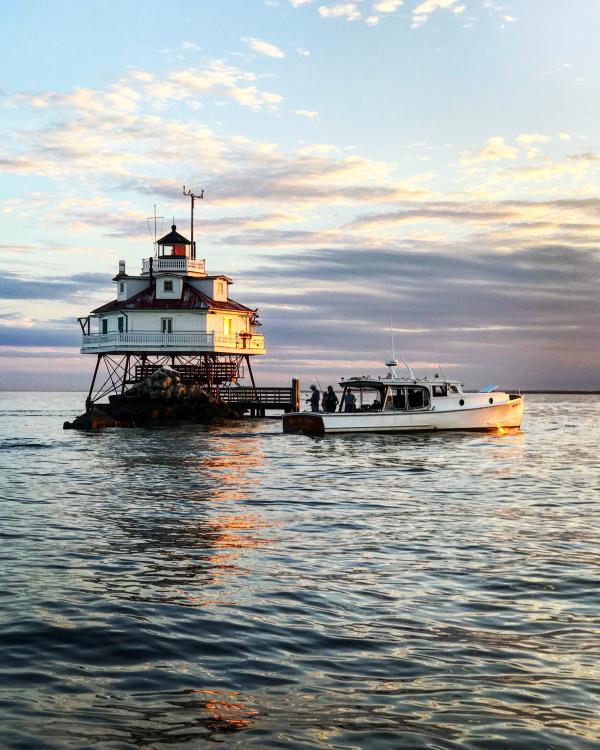After a choppy, 30-minute ride from the dock behind the Annapolis Maritime Museum, the motor launch suddenly slows, the noise subsides, and the 18 passengers strain for a close-up view of one of the most photographed and charming icons on the Chesapeake Bay: Thomas Point Shoal Lighthouse.

Getting there has been worth it. The six-sided cottage, painted stark white with a bright red roof and resting on a framework of cast-iron pilings, is just as eye-pleasing close up as it is from a mile or so away, the view most boaters get. This is the real McCoy. In Maryland, this lighthouse image is ubiquitous. It adorns thousands of items, from menus to tote bags. As befits such a venerable landmark, Thomas Point Light boasts several distinctions.
Built in 1875, it’s the last cottage-style screwpile lighthouse still sitting in its original location and still serving as a working navigational aid. It’s a National Historic Landmark, in company with the White House and the U.S. Capitol. And arguably, it’s the best-known icon on Chesapeake Bay. Its interior is a jewel as well. Although refurbishing is still a work-in-progress, the three-story, seven-room cottage is being carefully restored to what it looked like in 1901, when it housed two live-aboard lightkeepers. Knowledgeable docents can tell you how the original lighthouse operated and what has been returned to its early-1900s state.
“It’s a thrill for people to get inside, to get a feel of what life was like in the lighthouse,” says Virginia Crespo, a former Anne Arundel County high school history teacher who serves as a senior docent. She’s also an off-duty antiques scout for late-19th-century furniture and cooking utensils that help enhance the interior’s Victorian look. Over the past 12 years, restoration crews—mostly volunteers from the Chesapeake Chapter of the U.S. Lighthouse Society—have ripped out postwar-era panels, scraped off old paint, replaced water-logged decking, repainted and varnished walls and woodwork, and collected old furniture and tools to bring the interior of the lighthouse back to its earlier condition. Not quite finished are the galley, which is equipped with an early-1900s stove, sink, and pantry, but still lacks working utilities; a front parlor, almost ready for serious furnishing; and a bedroom that once housed a large diesel generator that was used to provide the light with power during emergencies. (The bedroom is still filled with tools, paint, and lumber.)
The one room that won’t be re-done in Victorian style is a former bedroom that the Coast Guard used as a watchstanding room when it manned the lighthouse with petty officers, from 1939 to 1986. Instead, it’s been furnished in the style of the mid-1980s, with government-surplus plain gray desks, an old radio and charts, and a vintage black-and-white television set. “We’ve had retired Coast Guardsmen touring the lighthouse who actually were part of the crew who manned it over the years,” Crespo says. “They’re just chock-full of stories about what it was like and the storms they went through. They say the refurbished watchstanding room is exactly like the one they used when they were serving here.” Apart from its cottage-like appearance, what distinguishes Thomas Point most is that, unlike most shorebound lighthouses, it looks as though it’s been plunked right in the middle of the Bay. The reason: the shoals around Thomas Point extend almost a mile and a half into the water, and the light itself is there to warn mariners away. So it makes sense to put the lighthouse there.
Indeed, two earlier lighthouses at Thomas Point—one built on a shoreside bank in 1824, and a second built in 1842—were destroyed after erosion quickly washed away the land, leading Congress to order that the present light be located farther out on the shoal and embedded deep into the mud. Although the 1875 plan for the current lighthouse initially called for a cylindrical caisson, planners later decided on a screwpile lighthouse on grounds that it would be less expensive. As with all screwpile lighthouses, a large cast-iron piling and six perimeter pilings were literally screwed 12 feet into the bottom to act as anchors. The cottage was built over them.
In the early 2000s, the Coast Guard, faced with another budget squeeze, finally decided to take Thomas Point off its books, and in 2004 the structure was transferred to a consortium that includes the City of Annapolis, Anne Arundel County, the Annapolis Maritime Museum, and the U.S. Lighthouse Society. The Coast Guard still maintains the structure’s large Fresnel beacon, which still functions as a navigational aid and displays a flashing white light that’s visible from 11 miles away. You can climb up and take a peek at it during the tour. The cupola and roof also support an array of weather instruments and other gear that feed data into National Weather Service computers.
Renovation began in 2004, and there was plenty to do. Besides repairing the damage from weather and ice floes, the consortium had to fix the damage from Hurricane Isabel, which had battered the Annapolis area the year before and devastated the lighthouse’s docks, an under-the-cottage storage building, outside walkways, and portions of the roof. Henry Gonzalez, manager of the renovation project, says the consortium has spent about $500,000 so far on fixing up the lighthouse, a relatively modest amount considering how much work was needed.




